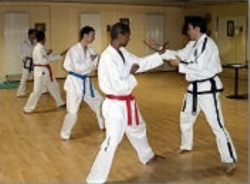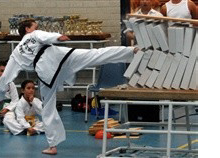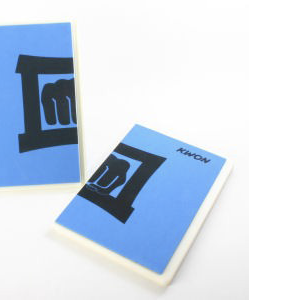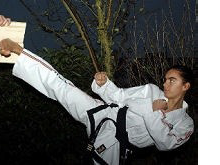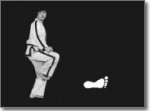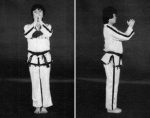Student Booklet - 5th KUP exam (Green belt / Blue tag)
Student booklet /
Main Menu
Student Booklet - 5th KUP exam (Green belt / Blue tag)
Exam 5th Kup
Student booklet
Select the level of the exam or the full booklet in the following box to have the theory you require :
Won-Hyo Historical background (TAEKWONDO YOKSA) for 5th KUP exam
"WON-HYO" was the name of the monk who introduced Buddhism to the Silla Dynasty in the year 686 AD.
END: Bring the right foot back to MOA SOGI A
Back to top of page - Back to Welcome Page
Knowledge of Taekwondo for 5th KUP
Matsogi
Reminder
Taekwondo students learn the techniques of Matsogi. Those are taught with the movements from the tuls to learn how to apply them in sparring.
There are three types of Matsogi: Sambo Matsogi (three step sparring), Ibo Matsogi (two-step sparring) and Il- bo Matsogi (one step sparring).
For the yellow belt exam, candidates must perform five three steps. This is done in pairs.
Methodology
You stand facing each other, bow to each other, then the attacker (pre-arranged) measures the distance needed to perform the attack. After that, the attacker goes backward with his right leg in gunnun sogi najunde bakat palmok makgi. This is the initial position in which each three-step is carried out.
In theory, the defender determines which attack will be performed, but for practical reasons (on the distance between the performers), we recommend that the attacker decides which attack he will be performing. After all, the defender knows beforehand what technique the attacker will use).
Once the attacker has called the technique, he states that he is ready to attack ("TSE"). The defender ponders what technique he will use to defend and indicates that he is ready ("TSE"). The defender may take his time to get prepared for.
Afterwards the attacker kicks or punches and the defender defends/blocks three times. The defender then performs a counterattack.
Then reverse roles. The attacker brings his front leg back to NARANI SOGI (ie backwards) and the defender brings his back leg forward to NARANI SOGI. Now it's up to the person who has just defended for to attack.
Attention to:
It is important to set the feet in the right place. In an attack in niunja sogi, the attacker's feet are placed on the outside of the feet of the defender. If an attack is in gunnun sogi the foot of the attacker is placed on the right side of the foot of the defender, so first on the outside and second time on the inside.
The defender performs a counterattack depending on the distance between the two people. If the distance is large then a kicking technique can be used; it is recommended to have a hand technique at a short distance.
Back to top of page - Back to Welcome Page
For the exam
The student must perform 12 SAMBO MATSOGI program. In addition, the student must be able perform 5 IBO MATSOGI (two step sparring).
The difference with the three-step consists in the method of attack: in contrast to the three step sparring, where the attacker attacked three times with the same attack, the attack is two-step sparring consists off two different attacks; one kick and one punch, or vice versa.
Similarly, the starting position, in which the attacker starts, is different from the SAMBO MATSOGI.
Instead of a GUNNUN SOGI NAJUNDE BAKKAT PALMOK MAKGI, the attacker begins in NIUNJA SOGI PALMOK DAEBI MAKGI.
Back to top of page - Back to Welcome Page
BREAK TECHNIQUES OR KYEK PA
Many think that they need a big shape and size needed to break a board. But that is not so. There are different things to look at. Here are the factors which lead to a higher degree of physical strength.
- Action-Reaction : Every force has an equal and opposite force. Therefore, in taekwondo with every move you make, the hand is quickly withdrawn to the hip.
- Concentration: The maximum power is only given at the time of impact.
- Balance: The body is balanced with each technique. This can be done by taking a proper position to take.
- Breathing: The control of breathing not only affects the speed and power. It can also prepare the body for a fight. Never breathe at the moment of the impact!
- Wave motion: Relationship strength - relaxation.
- Speed: Speed is the most essential factor when invoking force or pressure.
Scientifically, force equals mass times acceleration
Force = mass x speed
To know :
The bursting test must be passed with 1.5 to 3.5 cm wide pine 30x30 cm plank of wood.
How to proceed?
- Come to the place, then greet.
- Measure the distance down to the shelf. Take a good distance, certainly not too short.
- Breathe in and out. Measure one more time the distance.
- Come in JUNBI.
- Break the shelf.
- Come back in JUNBI.
- Greet.
Note: Always be peaceful and calm. Remember, use your whole body. You break the board with your hips and shoulders. Get it off your power. Also remember; you won’t try to break it; you will break it.
Back to top of page - Back to Welcome Page
Hand-Technique for 5th KUP
| Korean | English |
|---|---|
| NOPUNDE SONKAL ANURO TAERIGI | High knife-hand inward strike |
| AN PALMOK DOLLIMYO MAKGI | Forearm circular block |
Back to top of page - Back to Welcome Page
Foot-Technique for 5th KUP
| Korean | English |
|---|---|
| YOP CHAGI | Side piercing kick |
| YOPCHA JIRUGI | Side piercing kick and punch together |
Back to top of page - Back to Welcome Page
GOJUNG SOGI - Fixed Stance
This is an effective mode to work out for an attack or go to the side. This position is equal to the short mode (niunja sogi) with the following exceptions:
- Body weight is evenly distributed on both legs.
- The distance between both feet is one and a half shoulder width.
When the right leg is forward, we call the position a right fixed stance and when the left leg is forward we call it a left fixed position.
The stand is always performed in a side facing.
Back to top of page - Back to Welcome Page
GUBURYO SOGI - Bending Stance
This position serves as a preparatory position for backward and lateral steps, generally defensive movements.
While standing on the right leg, there is a right flexed position, vice versa.
You can execute the position in full facing or side facing.
Back to top of page - Back to Welcome Page
MOA SOGI A - Closed Stance
A starting position in which with the feet are against each other. Possible executable with full face or a side facing.
Some of the 24 patterns, starting with this position.
Back to top of page - Back to Welcome Page
Grading to the 5th Kup (Green Belt - Blue Tag)
- All previous knowledge you had to learn
- Meaning of Do-San
- Meaning of the Green Belt
- New techniques to know, being able to show and explain
- To name the different dynasties that were in Korea
- Correctly perform Dan-Gun Tul
- Correctly perform Do-San Tul
- Correctly perform 12 different Sambo Matsugi's (three step sparring)
- 2 min fight with a partner for the purpose to demonstrate different learned techniques during a fight
Back to top of page - Back to Welcome Page
